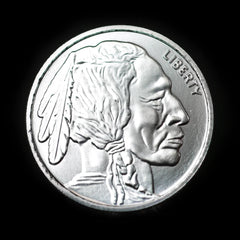I have used the Gold to Silver ratio countless times over the past 16 years to help me determine the best way to allocate my funds to precious metals. I have found it useful in identifying trends and analyzing historical data to understand past fluctuations in the gold to silver ratio, as well as setting expectations with respect to price development.
But the Gold to Silver ratio has major limitations and, in my opinion, I think it gets overused by Gold & Silver investors / stackers. Buyers, including both individual investors and institutional traders, often use the ratio and related tools to inform their purchasing decisions and evaluate which metal may be undervalued or poised to outperform. So, let me please explain:
You can also use an interactive chart to visualize and explore changes in the gold to silver ratio over time.
-
What I think the GSR is good for.
-
What I wouldn’t the GSR for.
-
How I use the GSR when planning purchases.
-
What I think about trading the GSR in search of growing my investment / stack.

Article on gold & silver price consolidation period from Kitco News:
https://www.kitco.com/news/article/2024-06-19/gold-and-silver-caught-prolonged-consolidation-prices-will-head-higher-saxo
Introduction to Precious Metals
The world of precious metals is both captivating and complex, with gold and silver standing out as two of the most sought-after and widely traded metals. For many investors and collectors, understanding the dynamics of gold and silver is essential for making smart investment decisions. One of the most useful metrics in this space is the gold silver ratio, which tells you how many ounces of silver are needed to buy one ounce of gold. This ratio is always measured in troy ounces—a standard unit in the precious metals market, where one troy ounce equals 31.1035 grams.
The gold silver ratio is calculated by dividing the current price of gold per ounce by the current silver price per ounce. For example, if the price of gold is $2,300 per ounce and the silver price is $30 per ounce, the gold silver ratio would be about 76.6. This means it would take roughly 76.6 ounces of silver to purchase one ounce of gold. By following the gold silver ratio chart, investors can track how this relationship changes over time and use it as a guide for their investment decisions.
Tracking silver prices and gold and silver prices on a daily basis is crucial for anyone looking to buy gold, purchase silver, or sell gold and silver bullion. The silver market is known for its volatility, with prices that can fluctuate rapidly due to shifts in demand, supply, and broader economic factors. The gold to silver ratio helps investors gauge whether silver is cheap compared to gold or expensive compared to historical averages, making it a useful metric for timing investments in physical gold, silver coins, and silver bullion.
Physical gold and silver bullion remain popular choices for those seeking a hedge against inflation and economic uncertainty. Many investors choose to buy gold bars or silver coins as a way to preserve wealth and diversify their portfolios. The current silver price and gold price are closely watched, and the silver ratio chart provides a visual tool to help investors track trends and spot potential opportunities in the market.
For those new to precious metals, it’s helpful to learn about the different types of metals available—such as gold, silver, and platinum—and the various ways to invest, including physical bullion, exchange-traded funds (ETFs), and futures contracts. Understanding the gold silver ratio and other key metrics can help investors make more informed choices and potentially outperform silver or gold in certain market conditions.
The gold silver ratio has a rich history, dating back to ancient Greece and Rome, where it was used to determine the value of gold and silver coins. Today, the ratio continues to play a central role in the precious metals market, influenced by factors like monetary stability, inflation, and global demand. As we look to the next few years, demand for precious metals is expected to remain strong, with the silver market in particular likely to see significant price swings.
Staying up to date with the latest trends, spot prices, and interactive charts is essential for anyone looking to invest in gold or silver. By understanding the gold silver ratio and using tools like the gold silver ratio chart, investors can make better decisions, track their investments, and work toward their financial goals in the ever-evolving world of precious metals. Whether you’re a seasoned investor or just starting out, keeping an eye on these key metrics can help you navigate the market with greater confidence.
What Is The Gold To Silver Ratio?
To start, it is only appropriate to introduce the gold to silver ratio (also known as the GSR) so everyone has a clear understanding of what it is. How the gold to silver ratio is calculated is like this: it is determined by dividing the spot price of gold by the spot price of silver. This means the ratio reflects the current market prices, or spot prices, of both metals at a given time.
When viewing a gold silver ratio chart, the chart displays the values of the ratio over time. These values represent the quantitative data points, helping investors interpret trends and understand the scale of fluctuations in the ratio.

Find reliable Gold & Silver price data here from Trading View:
https://www.tradingview.com/symbols/XAUUSD/
https://www.tradingview.com/symbols/SILVER/
There is a lot of disagreement amongst experts today as to whether this measure between metals is still relevant in the 21st century. Here are some examples of different opinions as they relate to the GSR:
- Some argue that the ratio today is proof of how undervalued silver is in relation to gold.
- Some argue that the current ratio suggests gold is overpriced and due for a downward correction.
- Others argue that the ratio is no longer relevant citing a clear shift towards gold as the preferred monetary metal and store of value.

An objective truth is very difficult to come to, but there is enough evidence to make some conclusive statements for people looking to use this indicator in the 21st century.
What Is The Gold To Silver Ratio Good For?
From my point of view, the Gold to Silver Ratio is a great “local top” indicator for the prices of precious metals. What do I mean by local top? What I mean is that when the GSR hits certain levels, it is a sign that precious metals prices are likely poised for a pullback. A low ratio can often signal a market top or a potential shift in investment strategy between the two precious metals. How can I tell? More often than not, when we see a major drop in the gold to silver ratio (meaning the price of silver grows much quicker than gold), it is fueled by a runup in price for both gold & silver during bull markets, when both metals tend to rise together, and usually followed by a period of price weakness.

Link to Gold to Silver Ratio chart from Macro Trends:
https://www.macrotrends.net/1441/gold-to-silver-ratio
Why do I think this indicator works? The main reason is because of the speculative nature of silver. Silver is of course real money, and an increasingly important industrial ingredient in the 21st century. I am bullish on silver over the long-term! That said, in a metals bull market I have observed the following events (in order) leading to a top before a pullback:
- Gold price rises as “big money” investors move into gold as a hedge to inflation / uncertainty.
- As gold picks up momentum, regular retail investors move into the cheaper of the 2 monetary metals (silver) due to affordability & speculative return.
- These waves of retail speculation result in larger and faster moves up in the price of silver.
- As the GSR moves down significantly (usually below 50), “big money” investors have already allocated their money and retail investors are running out of new money to invest in metals.
- High prices give an incentive for speculators to sell for fiat currency profits.
- Prices pullback or stagnate for some time.
How I Allocate Cash Savings Into Metals Based On The Gold To Silver Ratio
Apart from using the GSR as a market top indicator, I reference the ratio when allocating my cash savings to precious metals. Before I explain how, please keep in mind that my strategy for saving in precious metals is a long-term plan where I convert cash into metals over time. That is why I use the Dollar Cost Average (DCA) approach when purchasing gold & silver (because I see it as a long-term savings mechanism).

More on the Dollar Cost Average strategy from Investopedia here:
https://www.investopedia.com/terms/d/dollarcostaveraging.asp
How I incorporate the Gold to Silver Ratio into my Dollar Cost Average strategy as follows:
- When the GSR is above 80 (meaning 1 ounce of gold is equal or greater than the price of 80 ounces of silver) I try to purchase roughly 20 to 40 ounces of silver for every ounce of gold. I think as someone gets older; they should buy at the lower level of that range. For younger stackers (below 35 years of age); buying at the higher end of that range may make more sense (especially for younger people on a tight budget as I once was).
- When the GSR is below 60, I try to purchase roughly 10 ounces of silver for every ounce of gold. Considering that pullbacks below 50 usually signal a top in the price of precious metals (as demonstrated above), slowing down silver purchases in that range is a more prudent way to stack as far as I’m concerned.
What SHOULDN’T the Gold To Silver Ratio Be Used For?
The main mistake I see many silver investors & stackers make is they point to their preferred gold to silver ratio and say – “that’s the real ratio, so I’ll assume the price of silver will move up to that ratio versus the current price of gold”. They often incorrectly believe that if gold and silver prices change by the same amount, their values will remain in sync, which overlooks the complexities of the market. Doing that, many people begin to plan their financial strategies or retirement around numbers that are purely theoretical. This is not only a poor way of using the gold to silver ratio, especially when making decisions about investing in physical silver, it can also be hazardous to one’s financial security!

More on precious metals reserves & mines amounts in history from the Royal Mint here:
https://www.royalmint.com/articles/invest/how-much-precious-metals-exists-on-earth-and-how-much-has-been-mined/
This type of thinking, in my opinion, is flawed and extremely 1-dimensional. What do I mean by that?
- It does not factor in the possibility that gold is overpriced or overvalued by the market.
- It assumes gold & silver are equal in every way, therefore value can only be separated by supply / scarcity.
- It leaves out key trends such as Central Bank purchasing preferences (gold as a Tier 1 asset), industrial usage, cultural practices, etc.
- It gives too much relevance to historical norms that were agreed on by people for various reasons that have little relevance in the 21st century.
Does that mean I think the current Gold to Silver ratio is useless in examining price potential for silver? No, it doesn’t! I think it’s fair to look at the Gold to Silver ratio to build models and expectations of where prices may go. What I am saying is, we should use observed GSR ranges since 1971 (when the USA officially abandon the gold standard) as a guide based on averages and trends within that data set. What we shouldn’t do is defer to out of modern context ratios that have nothing to do with the real long-term macroeconomic picture.
The best example I can think of to illustrate what I mean by that is this – Elon Musk and I are both human beings. We are at a ratio of 1:1 as we both exist as single individuals on planet earth. That does not mean our value is the same. Believe me when I say that Elon Musk is much more valuable to the world than I am (sorry mom)! The same applies to gold & silver. Just because they may come out of the earth at a ratio of 8 to 1, we should not assume any value based on that ratio.

Investopedia article on why humans value gold so much:
https://www.investopedia.com/articles/investing/071114/why-gold-has-always-had-value.asp
So, What Is A Realistic Gold To Silver Ratio In My Opinion?
Based on observed trends and performance since 1971 (considering that 47 is the average GSR of the 20th Century), I think a GSR of 40 to 60 is a realistic level we may see more often over the next 20 to 30 years. This range can also help guide long-term decisions about silver investments, as shifts in the gold-silver ratio often indicate when it may be advantageous to adjust investment focus between gold and silver.

Link to Gold to Silver Ratio chart from Macro Trends:
https://www.macrotrends.net/1441/gold-to-silver-ratio
Does It Make Sense To Trade The Gold To Silver Ratio Based On The Expectation Of It Falling?
Remember, physical metals come with premiums. Without premiums, it would be very difficult to purchase metals because there would be no incentive to start a business that sells them. So, let me start by saying we should not demonize sellers that provide metals at reasonable and fair premiums.
That said, those very premiums make it difficult for physical metals investors / stackers to “play” or trade the gold to silver ratio. Why is that? Because you pay premiums one way when buying the metal, and when it comes time to trade, you sell back for cash (close to spot) and buy once again at a premium. Investors often use the gold/silver ratio to identify optimal times for selling gold in order to maximize profits, but these premiums can reduce the effectiveness of such strategies. Tracking live gold price updates and ratio charts is essential for making timely trading decisions, but the impact of premiums means that paying the premium twice significantly eats into any tangible “profits” you may have expected to benefit from.

Link to a great video by my friend 2is1 on the topic of trading the Gold to Silver Ratio:
https://www.youtube.com/watch?v=TIvTm-h1Djw
Of course, it doesn’t mean it’s impossible to trade based on the GSR, it just means that it may be a more profitable trade in the paper market than in the physical metals market. For that reason, instead of planning trades based on the GSR, I think it’s best to plan your purchases around the GSR (as touched on above) to get the best value for your hard-earned cash.
Final Thoughts
The gold to silver ratio is an analytical measure as old as gold & silver money itself. Although I think it is a relevant tool in the 21st century, I think most people use it incorrectly or with false expectations on how to gain from it.
The world is a complex place and there are many factors that impact the US Dollar prices of gold & silver independently of each other. So, although I encourage people to use the ratio to strengthen their understanding of precious metals price performance, I also encourage them to look beyond that single indicator to get a fuller picture of what is really happening.
To stay updated on the latest gold and silver ratio values and market changes, create a free account to receive alerts and personalized notifications directly to your inbox.






